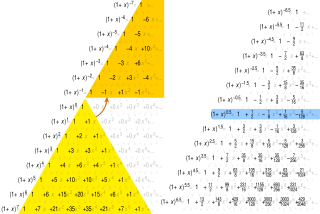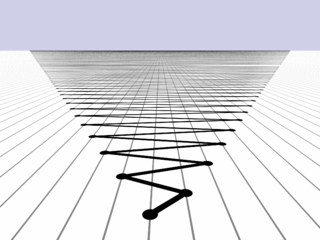In mathematics, a series is, roughly speaking, the operation of adding infinitely many quantities, one after the other, to a given starting quantity. The study of series is a major part of calculus and its generalization, mathematical analysis. Series are used in most areas of mathematics, even for studying finite structures through generating functions. In addition to their ubiquity in mathematics, infinite series are also widely used in other quantitative disciplines such as physics, computer science, statistics and finance.
Zeno's paradoxes are a set of philosophical problems generally thought to have been devised by Greek philosopher Zeno of Elea to support Parmenides' doctrine that contrary to the evidence of one's senses, the belief in plurality and change is mistaken, and in particular that motion is nothing but an illusion. It is usually assumed, based on Plato's Parmenides (128a–d), that Zeno took on the project of creating these paradoxes because other philosophers had created paradoxes against Parmenides' view. Thus Plato has Zeno say the purpose of the paradoxes "is to show that their hypothesis that existences are many, if properly followed up, leads to still more absurd results than the hypothesis that they are one." Plato has Socrates claim that Zeno and Parmenides were essentially arguing exactly the same point. Some of Zeno's nine surviving paradoxes are essentially equivalent to one another. Aristotle offered a refutation of some of them. Three of the strongest and most famous—that of Achilles and the tortoise, the Dichotomy argument, and that of an arrow in flight—are presented in detail below.
Hypercomputation or super-Turing computation refers to models of computation that can provide outputs that are not Turing-computable. Super-Turing computing, introduced in the early 1990's by Hava Siegelmann, refers to such neurological inspired, biological and physical realizable computing; It became the mathematical foundations of Lifelong Machine Learning. Hypercomputation, introduced as a field of science in the late 1990s, is said to be based on the Super Turing but it also includes constructs which are philosophical. For example, a machine that could solve the halting problem would be a hypercomputer; so too would one that can correctly evaluate every statement in Peano arithmetic.
In philosophy, a supertask is a countably infinite sequence of operations that occur sequentially within a finite interval of time. Supertasks are called hypertasks when the number of operations becomes uncountably infinite. A hypertask that includes one task for each ordinal number is called an ultratask. The term "supertask" was coined by the philosopher James F. Thomson, who devised Thomson's lamp. The term "hypertask" derives from Clark and Read in their paper of that name.
In mathematical analysis, Cesàro summation assigns values to some infinite sums that are not necessarily convergent in the usual sense. The Cesàro sum is defined as the limit, as n tends to infinity, of the sequence of arithmetic means of the first n partial sums of the series.
In mathematics, a divergent series is an infinite series that is not convergent, meaning that the infinite sequence of the partial sums of the series does not have a finite limit.
In mathematics and computer science, Zeno machines are a hypothetical computational model related to Turing machines that are capable of carrying out computations involving a countably infinite number of algorithmic steps. These machines are ruled out in most models of computation.

The coastline paradox is the counterintuitive observation that the coastline of a landmass does not have a well-defined length. This results from the fractal curve-like properties of coastlines; i.e., the fact that a coastline typically has a fractal dimension. Although the "paradox of length" was previously noted by Hugo Steinhaus, the first systematic study of this phenomenon was by Lewis Fry Richardson, and it was expanded upon by Benoit Mandelbrot.

The Ross–Littlewood paradox is a hypothetical problem in abstract mathematics and logic designed to illustrate the paradoxical, or at least non-intuitive, nature of infinity. More specifically, like the Thomson's lamp paradox, the Ross–Littlewood paradox tries to illustrate the conceptual difficulties with the notion of a supertask, in which an infinite number of tasks are completed sequentially. The problem was originally described by mathematician John E. Littlewood in his 1953 book Littlewood's Miscellany, and was later expanded upon by Sheldon Ross in his 1988 book A First Course in Probability.
In mathematics, the infinite series 1 − 1 + 1 − 1 + ⋯, also written

This article lists occurrences of the paradoxical infinite "sum" +1 -1 +1 -1 ..., sometimes called Grandi's series.

In mathematics, 1 − 2 + 3 − 4 + ··· is an infinite series whose terms are the successive positive integers, given alternating signs. Using sigma summation notation the sum of the first m terms of the series can be expressed as

The infinite series whose terms are the natural numbers 1 + 2 + 3 + 4 + ⋯ is a divergent series. The nth partial sum of the series is the triangular number
In mathematics, 1 − 2 + 4 − 8 + ⋯ is the infinite series whose terms are the successive powers of two with alternating signs. As a geometric series, it is characterized by its first term, 1, and its common ratio, −2.

In mathematics, the infinite series 1/2 + 1/4 + 1/8 + 1/16 + ··· is an elementary example of a geometric series that converges absolutely. The sum of the series is 1. In summation notation, this may be expressed as

Infinity is that which is boundless, endless, or larger than any natural number. It is often denoted by the infinity symbol .
James F. Thomson (1921–1984) was a British philosopher who devised the puzzle of Thomson's lamp, to argue against the possibility of supertasks






